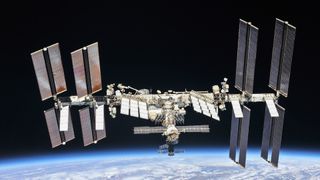International Space Station fires thrusters to avoid collision with satellite
The ISS playing dodgeball with debris and other satellites in low earth orbit (LEO) is becoming more common.

The International Space Station had to maneuver out of the way of an Earth-imaging satellite on Monday (March 6).
At approximately 7:42 a.m. (12:42 GMT), thrusters on the Progress 83 resupply vessel currently docked with the International Space Station (ISS) fired for a little more than six minutes, raising the station's orbit to prevent the potential collision, NASA said in a blog post.
The satellite in question appears to have been an Argentinian Earth-observation satellite launched in 2020, according to Sandra Jones, from NASA's Johnson Space Center. In a tweet, Dr. Jonathan McDowell, astronomer and astrophysicist at the Harvard–Smithsonian Center for Astrophysics, narrowed the possible candidates down to Nusat-17, noting the constellation's orbital decay.
Related: International Space Station: Facts about the orbital laboratory
Nusat-17 is one of ten commercial observation satellites that launched in 2020 and are operated by geospatial data company Satellogic. As McDowell points out in his tweet, the Nusat constellation is one of several whose orbits are slowly encroaching on the ISS's orbit.
Avoidance maneuvers like this aren't entirely uncommon for the space station. According to a December 2022 NASA report, the ISS has made a total 32 course corrections to avoid satellites and trackable space debris since 1999.

Last year, two such corrections were necessary to avoid debris from the Cosmos 1408 satellite, which Russia destroyed in an anti-satellite (ASAT) weapons test in November 2021 — a demonstration that has since been largely condemned by the international space community.
Get the Space.com Newsletter
Breaking space news, the latest updates on rocket launches, skywatching events and more!
Monday's course correction came with ample notice, with NASA receiving initial alerts for the potential collision approximately 30 hours ahead of the satellite's projected closest approach, Jones told Space.com. A pre-determined avoidance maneuver (PDAM) was calculated, and crews aboard the ISS in tandem with NASA and Roscosmos ground teams prepared for the scheduled thruster burn. However, "about 20 minutes prior to the PDAM, a 'green update' was received on the conjunction," Jones said, adding, "thrusters were already enabled so the burn was still conducted."
Monday's PDAM comes amidst a heavy traffic time for the ISS, and just a few days after the arrival of SpaceX's Crew Dragon Endeavour and the members of Crew-6. Within the next week, astronauts aboard the space station will say goodbye to the members of Crew-5, scheduled to depart as early as Thursday (March 9), and begin to prepare for the arrival of SpaceX's CRS-27 cargo Dragon, currently scheduled to launch March 14.
NASA's blog post states that the March 6 avoidance maneuver will not affect Crew-5's upcoming departure. In her statement to Space.com, Jones confirmed that position, adding, "this burn does not interfere with phasing for any of the upcoming space station traffic." NASA announced Wednesday afternoon that Crew-5 would undock from the ISS at 5:05 p.m. March 9, for a scheduled splashdown at 9:25 p.m. March 10.
Follow us @Spacedotcom, or on Facebook and Instagram.
Join our Space Forums to keep talking space on the latest missions, night sky and more! And if you have a news tip, correction or comment, let us know at: community@space.com.

Josh Dinner is Space.com's Content Manager. He is a writer and photographer with a passion for science and space exploration, and has been working the space beat since 2016. Josh has covered the evolution of NASA's commercial spaceflight partnerships, from early Dragon and Cygnus cargo missions to the ongoing development and launches of crewed missions from the Space Coast, as well as NASA science missions and more. He also enjoys building 1:144 scale models of rockets and human-flown spacecraft. Find some of Josh's launch photography on Instagram and his website, and follow him on Twitter, where he mostly posts in haiku.
